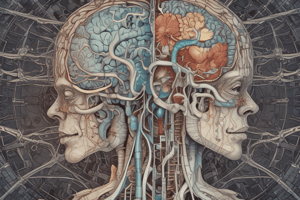Podcast
Questions and Answers
How many pairs of cranial nerves are there?
How many pairs of cranial nerves are there?
- 12 (correct)
- 14
- 10
- 8
Which cranial nerve is associated with the sense of smell?
Which cranial nerve is associated with the sense of smell?
- Facial (VII)
- Vagus (X)
- Olfactory (I) (correct)
- Glossopharyngeal (IX)
How many pairs of spinal nerves are there?
How many pairs of spinal nerves are there?
- 30
- 28
- 31 (correct)
- 33
Which nerve plexus is associated with the hip and lower limbs?
Which nerve plexus is associated with the hip and lower limbs?
What type of neurons do the ventral roots of spinal nerves contain?
What type of neurons do the ventral roots of spinal nerves contain?
Which type of nerve fibers do the rami communicantes carry?
Which type of nerve fibers do the rami communicantes carry?
Where are exteroceptors located?
Where are exteroceptors located?
What is the function of the dorsal ramus of a spinal nerve?
What is the function of the dorsal ramus of a spinal nerve?
Which structure controls the lens shape and causes the lens to focus?
Which structure controls the lens shape and causes the lens to focus?
Where are the photoreceptors for dim light vision and black and white perception located?
Where are the photoreceptors for dim light vision and black and white perception located?
Which part of the eye forms the area of greatest visual acuity?
Which part of the eye forms the area of greatest visual acuity?
What is the function of the tympanic membrane?
What is the function of the tympanic membrane?
Which part of the inner ear is responsible for hearing?
Which part of the inner ear is responsible for hearing?
What is the function of the pharyngotympanic tube?
What is the function of the pharyngotympanic tube?
Where are the mechanoreceptive hair cells with cilia located in the inner ear?
Where are the mechanoreceptive hair cells with cilia located in the inner ear?
What is the function of the vestibular membrane in the cochlea?
What is the function of the vestibular membrane in the cochlea?
Which part of the eye contains a fluid similar in composition to plasma and is replaced approximately every 90 minutes?
Which part of the eye contains a fluid similar in composition to plasma and is replaced approximately every 90 minutes?
What is the function of the vitreous humor in the eye?
What is the function of the vitreous humor in the eye?
Which part of the eye forms the 'blind spot' due to the absence of rods or cones?
Which part of the eye forms the 'blind spot' due to the absence of rods or cones?
What part of the eye is highly vascular and contains melanin?
What part of the eye is highly vascular and contains melanin?
What do interoceptors detect?
What do interoceptors detect?
Which stimuli do mechanoreceptors respond to?
Which stimuli do mechanoreceptors respond to?
How many successive neurons are involved in neuronal pathways?
How many successive neurons are involved in neuronal pathways?
Which tracts are included in the ascending tracts?
Which tracts are included in the ascending tracts?
What does the autonomic nervous system consist of?
What does the autonomic nervous system consist of?
What does the somatic nervous system include pathways for?
What does the somatic nervous system include pathways for?
How many neurons are involved in the autonomic nervous system pathway?
How many neurons are involved in the autonomic nervous system pathway?
What are the subdivisions of the autonomic nervous system?
What are the subdivisions of the autonomic nervous system?
What are the components of the eye's fibrous tunic?
What are the components of the eye's fibrous tunic?
What is the function of the transparent anterior 'window' in the eye?
What is the function of the transparent anterior 'window' in the eye?
How do sympathetic and parasympathetic nervous systems differ?
How do sympathetic and parasympathetic nervous systems differ?
Flashcards are hidden until you start studying
Study Notes
Sensory Systems Classification
- Sensory systems are classified based on location, type of stimulus, and structure.
- Interoceptors detect internal stimuli in viscera and blood vessels.
- Mechanoreceptors respond to mechanical stimuli like pressure, touch, and vibration.
- Neuronal pathways involve ascending spinal pathways and their three successive neurons.
- Ascending tracts include posterior column, spinocerebellar, and anterolateral pathways.
- Motor systems consist of upper and lower motor neurons for somatic and autonomic nervous systems.
- The somatic nervous system includes direct and indirect motor pathways for voluntary and complex movements.
- The autonomic nervous system involves a two-neuron pathway with preganglionic and postganglionic neurons.
- It has sympathetic and parasympathetic subdivisions, with different functions and exit points from the CNS.
- The eye is a three-layered sphere filled with fluid, including the fibrous tunic with the sclera, conjunctiva, and cornea.
- The eye also has a vascular mucus membrane and a transparent anterior "window" for light to enter.
- The autonomic nervous system has a comparison between the sympathetic and parasympathetic nervous systems in terms of function, location, and nerves' exit points.
Studying That Suits You
Use AI to generate personalized quizzes and flashcards to suit your learning preferences.




